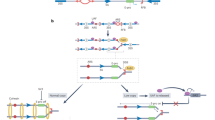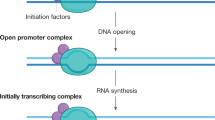Abstract
THE nucleolus is not a permanent organelle in the life of a cell; at the initiation of a new cycle, the nucleolar formation seems to depend on RNA synthesis directed by nucleolar RNA polymerase1. We have compared the rate of nucleologenesis in meristem cells of Allium cepa L. and in those of four Vicia species with different numbers of ribosomal cistrons and different DNA contents3,4 as well as the rate of nucleologenesis in four different cell populations lying side by side in the root of Zea mays. The rate of nucleologenesis per ribosomal cistron seems to be constant in the different species growing in similar conditions, but this mean rate was modified in metabolically different subpopulations in the same root.
This is a preview of subscription content, access via your institution
Access options
Subscribe to this journal
Receive 51 print issues and online access
$199.00 per year
only $3.90 per issue
Buy this article
- Purchase on Springer Link
- Instant access to full article PDF
Prices may be subject to local taxes which are calculated during checkout
Similar content being viewed by others
References
Giménez-Martín, G., de la Torre, C., Fernández-Gómez, M. E., and González-Fernández, A., J. Cell Biol., 60, 502–507 (1974).
Landesman, R., Cell Different., 1, 209–213 (1972).
Ingle, J., and Sinclair, J., Nature, 235, 30–32 (1972).
Maher, E. P., and Fox, D. P., Nature, 245, 170–172 (1973).
López-Sáez, J. F., Giménez-Martín, G., and González-Fernández, A., Z. Zellforsch., 75, 591–600 (1966).
Clowes, F. A. L., J. exp. Bot., 7, 307–312 (1956).
Clowes, F. A. L., J. exp. Bot., 9, 229–238 (1958).
Barlow, P. W., J. exp. Bot., 21, 292–299 (1970).
Stockert, J. C., Fernández-Gómez, M. E., Giménez-Martín, G., and López-Sáez, J. F., Protoplasma, 69, 265–278 (1970).
Mukherjee, A. S., and Beermann, W., Nature, 207, 785–786 (1965).
Ananiev, E. V., Faizullin, L. Z., and Grozdev, V. A., Chromosoma, 45, 193–201 (1974).
Miller, L., and Gurdon, J. B., Nature, 227, 1108–1110 (1970).
Knowland, J. S., and Miller, L., J. molec. Biol., 53, 321–338 (1970).
Fernández-Gómez, M. E., Stockert, J. C., López-Sáez, J. F., and Giménez-Martín, G., Stain Techn., 44, 48–49 (1969).
Risueño, M. C., Fernández-Gómez, M. E., and Giménez-Martín, G., Mikroskopie, 29, 292–298 (1973).
de la Torre, C., and Clowes, F. A. L., J. Cell Sci., 11, 713–721 (1972).
Author information
Authors and Affiliations
Rights and permissions
About this article
Cite this article
DE LA TORRE, C., FERNANDEZ-GOMEZ, M. & GIMENEZ-MARTIN, G. Rate of nucleologenesis as a measure of gene activity. Nature 256, 503–505 (1975). https://doi.org/10.1038/256503a0
Received:
Accepted:
Published:
Issue Date:
DOI: https://doi.org/10.1038/256503a0
This article is cited by
-
Role for early replicating DNA in preventing precocious nucleologenesis in proliferating plant cells
Protoplasma (1993)
-
Determination of the replication time of nucleolar organizer DNA after 5-azacytidine treatment for restricted parts of the S period
Protoplasma (1992)
-
Control of mitotic chromosome condensation and of the time of nucleolar formation in meristems by short life proteins
Protoplasma (1979)
-
Nucleologenesis and number of ribosomal RNA genes in maize
Genetica (1978)
Comments
By submitting a comment you agree to abide by our Terms and Community Guidelines. If you find something abusive or that does not comply with our terms or guidelines please flag it as inappropriate.



